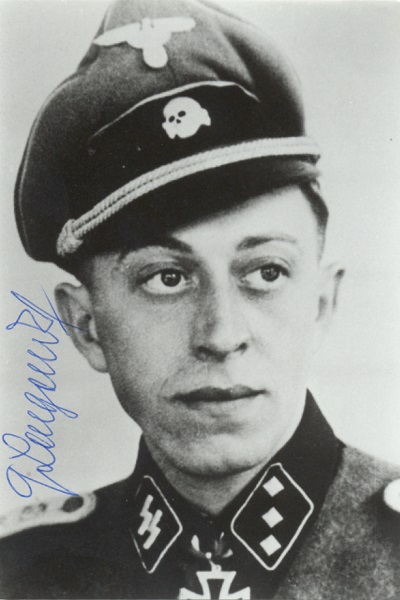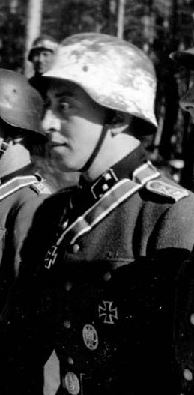Langendorf, Georg (Waffen SS)
- Date of birth:
- July 28th, 1920 (Gräfenhausen/Hesse, Germany)
- Date of death:
- January 28th, 1999 (Gräfenhausen/Hesse, Germany)
- Service number:
- SS-Nr.: // NSDAP-Nr.:
- Nationality:
- German (1933-1945, Third Reich)
Biography
Promotions:
?: SS-Untersturmführer;
?: SS- Obersturmführer.
Career:
November 20th, 1939: MG-Schütze 1;
November 1941: PAK Schütze 1;
March 1942: Geschützführer PAK;
February 9th, 1943: Lehrgang;
June 1st, 1943: Panzerjäger Zugführer;
January 24th, 1944 - March 30th, 1944 (Wounded in action): Kompanieführer 5.(schweren) / SS-Panzer-Aufklärungs-Abteilung 11;
October 1st, 1944: Kompaniechef;
April 19th, 1945 (Wounded in action): Kompaniechef 5.(schweren) / SS-Panzer-Aufklärungs-Abteilung 11.
Do you have more information about this person? Inform us!
- Period:
- Second World War (1939-1945)
- Awarded on:
- November 1st, 1941
- Period:
- Second World War (1939-1945)
- Awarded on:
- September 13th, 1942
- Period:
- Second World War (1939-1945)
- Awarded on:
- February 8th, 1943
- Period:
- Second World War (1939-1945)
- Rank:
- SS-Untersturmführer der Reserve (2nd Lieutenant of Reserves)
- Unit:
- Führer, 5. schwere Schwadron, SS-Panzer-Aufklärungs-Abteilung 11, 11. SS-Freiwilligen-Panzergrenadier-Division "Nordland"
- Awarded on:
- March 12th, 1944
"Operating as part of Kampfgruppe Wengler, the SS-Panzer-Aufklärungs-Abteilung 11 was assigned to secure the important crossroads at Gubanizy, northeast of Wolossowo.
On the 26.01.1944, an attack was mounted against the town by 56 Russian tanks, most of them T-34s. With them was a battalion of more than 350 men. Untersturmführer Langendorf, as the heavy kompanie's commander, secured ground in a general northeastern direction towards Torosowo with his anti-tank cannon platoon.
Despite the fact he had no artillery at his disposal and that our infantry had moved into rearward positions, Langendorf, of his own accord, had his crews manhandle his cannons forward in such a way that he was able to counter the attack in an effective manner.
Two assault guns that carried very little ammunition disengaged after a brief fire fight. Thus, it was up to Langendorf's anti-tank cannon platoon to face the main force of the Russian attack.
Through his reckless personal effort, Langendorf and his cannon platoon managed to destroy 24 tanks within two hours - 15 of them T-34s. An additional 6 Russian tanks were disabled by hits from Langendorf's anti-tank defense. 8 Russian tanks were destroyed by assault guns.
After having destroyed the initial waves of armor, Langendorf deployed gun-carrying armoured halftracks and personally led them to the town's southwestern perimeter, following an advance by straggling tanks. He drove them out again, thus keeping the supply route open in the first stage of the engagement.
Back at the northeastern perimeter, he gathered the weak infantry elements for local defense against Russian infantry and further incoming waves of enemy armour. On that day, Langendorf's anti-tank weapons destroyed 31 enemy tanks (22 of them T-34s) and disabled another 6 Russian tanks with their fire.
On the 27.01.1944, Langendorf successfully hit and destroyed another tank in Lagunovo.
On the 29.01.1944, once again 2 enemy tanks were hit, then personally disabled and blown up by Langendorf.
Thus, within these four days, Langendorf and elements of his Kompanie destroyed 34 enemy tanks and disabled 6.
The overall number of kills made at Gubanizy on the 26.01.1944 made it impossible for the enemy to carry out his intentions of pushing through Gubanizy and on to Wolossowo to take that town - an intention that has been confirmed through statements made by prisoners - thus making possible the orderly retreat movement of our own forces on the immediate right."
- Period:
- Second World War (1939-1945)
- Awarded on:
- March 30th, 1944
- Period:
- Second World War (1939-1945)
- Awarded on:
- June 4th, 1944
- Period:
- Second World War (1939-1945)
- Awarded on:
- June 18th, 1944
- Period:
- Second World War (1939-1945)
- Rank:
- SS-Obersturmführer der Reserve (1st Lieutenant of Reserves)
- Unit:
- Chef, 5. schwere Schwadron, SS-Panzer-Aufklärungs-Abteilung 11, 11. SS-Freiwilligen-Panzergrenadier-Division 'Nordland'
- Awarded on:
- March 30th, 1945
Sources
- Photo 1: Igor Poul
- Photo 2:
- - FELLGIEBEL, W.P., Elite of theThird Reich, Helion & Company Limited, Solihull, 2003.
- MOONEY, PETER, Waffen-SS Knights and their Battles, Schiffer Military History, 2016.
- PATZWALL, K. & SCHERZER, V., Das Deutsche Kreuz 1941-1945, Verlag Klaus D. Patzwall, Norderstedt, 2001.
- Personalakte
- Axis History Biographical Research via Axis History Forum













